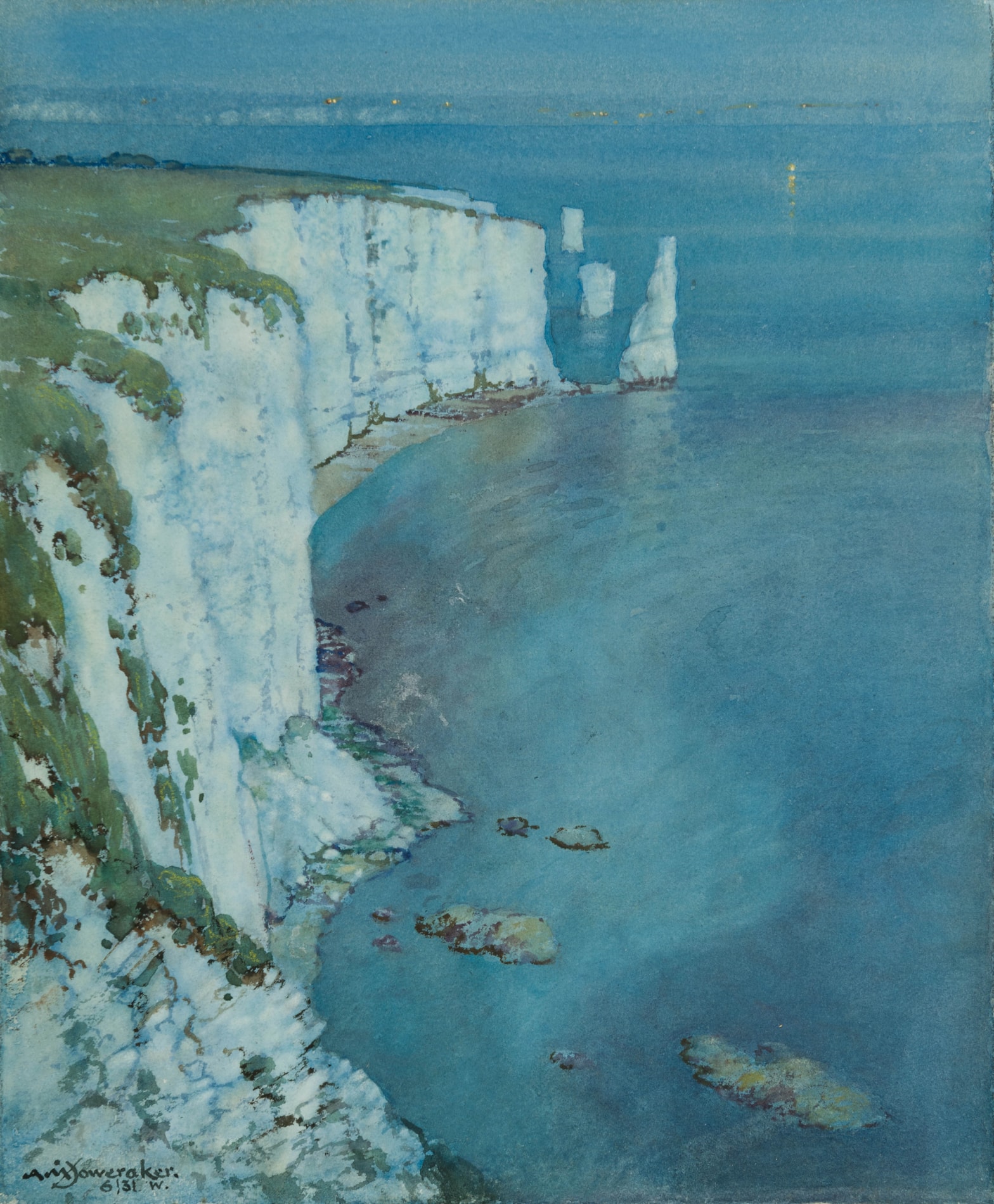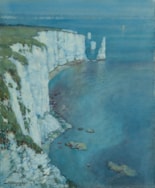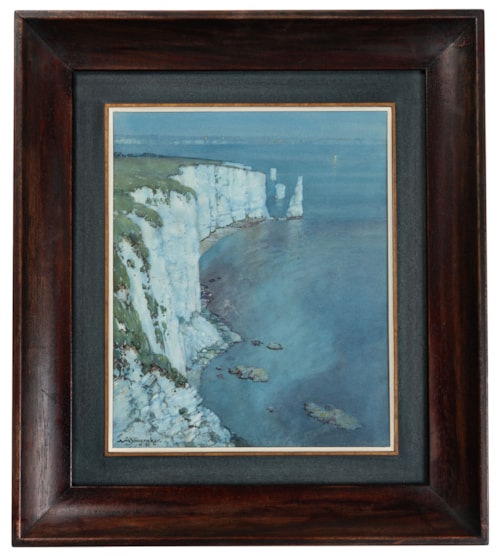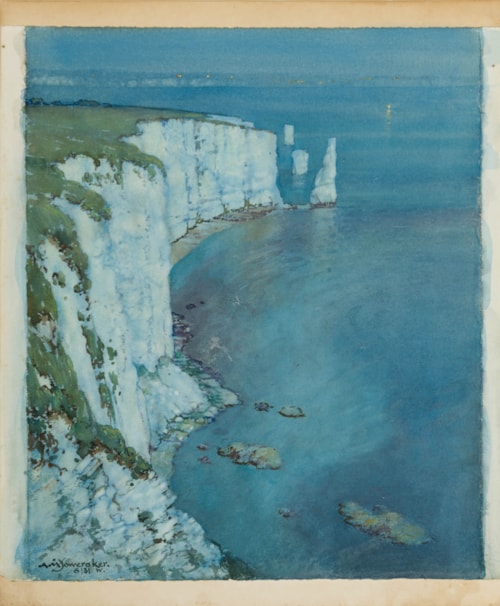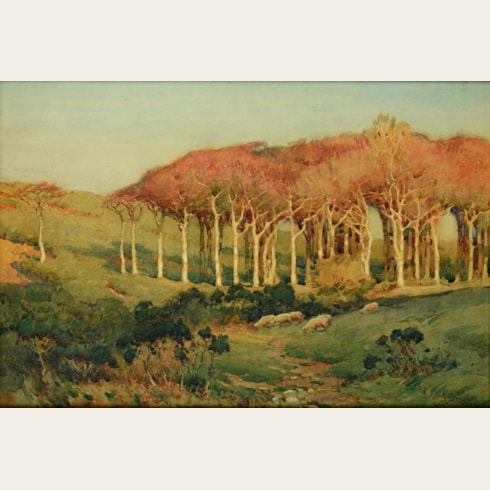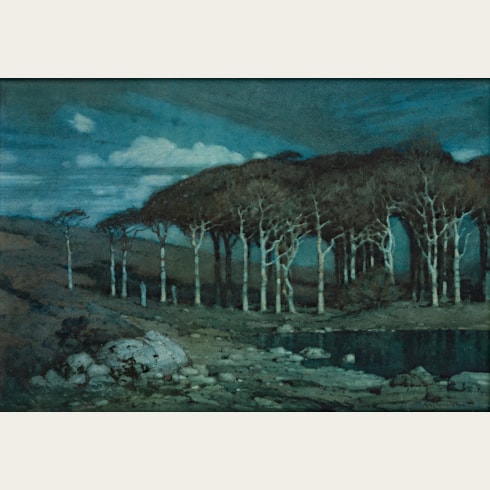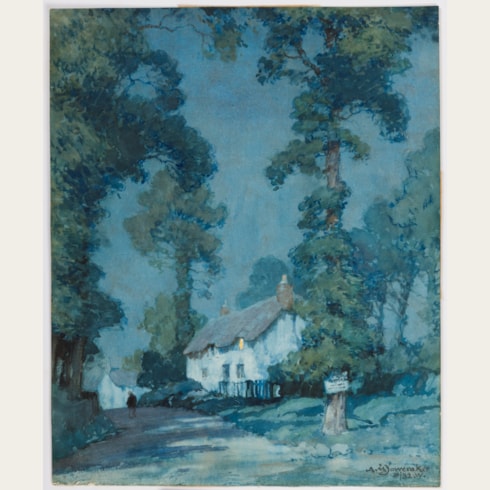Albert Moulton FOWERAKER
(Exeter 1873 - Swanage 1942)
Old Harry Rocks, Dorset
Sold
Watercolour and gouache, laid down on board.
Signed and dated AM Foweraker. / 6/31.W. at the lower left.
285 x 234 mm. (11 1/4 x 9 1/4 in.) [image]
285 x 260 mm. (11 1/4 x 10 1/4 in.) [sheet]
Signed and dated AM Foweraker. / 6/31.W. at the lower left.
285 x 234 mm. (11 1/4 x 9 1/4 in.) [image]
285 x 260 mm. (11 1/4 x 10 1/4 in.) [sheet]
Foweraker’s landscape paintings and watercolours are characterized by a particular interest in light effects, especially moonlight, and many of his works are dominated by an intense blue tonality. As one modern scholar has noted, ‘For watercolour subjects, Foweraker unsurprisingly painted a number of semi-rural scenes in the locality of his home in Carbis Bay...but he was also fond of exploring the coastline, capturing reflections in pools in the sand underneath craggy cliffs.’
Old Harry Rocks is the name given to three chalk sea stack formations at Handfast Point, at Studland Bay on the south coast of Dorset. The Rocks, which mark the easternmost point of the Jurassic Coast of East Devon and Dorset, were once part of a long stretch of chalk running between the Purbeck peninsula in Dorset and the Isle of Wight to the east, but were left as headlands by the effects of coastal erosion during the last ice age. As noted by a late 19th century geologist, ‘The “Old Harry” Rocks, off the Point, afford a good illustration of the “stacks” that result from marine denudation, and it is interesting to note that it is due to this long-continued action that the Chalk no longer stretches across the channel to the Needles, off the Isle of Wight, as once it did. Looking towards the land when off the “Old Harry”, we may see the pretty village of Studland nestling in the bay.’
Old Harry Rocks is the name given to three chalk sea stack formations at Handfast Point, at Studland Bay on the south coast of Dorset. The Rocks, which mark the easternmost point of the Jurassic Coast of East Devon and Dorset, were once part of a long stretch of chalk running between the Purbeck peninsula in Dorset and the Isle of Wight to the east, but were left as headlands by the effects of coastal erosion during the last ice age. As noted by a late 19th century geologist, ‘The “Old Harry” Rocks, off the Point, afford a good illustration of the “stacks” that result from marine denudation, and it is interesting to note that it is due to this long-continued action that the Chalk no longer stretches across the channel to the Needles, off the Isle of Wight, as once it did. Looking towards the land when off the “Old Harry”, we may see the pretty village of Studland nestling in the bay.’
A painter and watercolourist, Albert Moulton Foweraker earned a degree in applied science in 1893 and worked as an engineer and journalist in his native Exeter before taking up art as a full-time profession in 1898. In 1902 he was admitted to the Royal Society of British Artists, and the same year settled in the village of Lelant, near Carbis Bay in western Cornwall. He produced a number of views of the Cornish landscape and coastline and taught watercolour painting at Algernon Talmadge’s Cornish School of Landscape and Sea Painting in St. Ives. Foweraker exhibited regularly in London – showing over fifty works at the Royal Society of British Artists between 1902 and 1912 – and in a number of provincial galleries. His exhibition pictures were mainly landscapes and views in Devon and Cornwall, as well as Dorset, where he settled in the 1920s. Foweraker also travelled to Spain, France and North Africa, and exhibited numerous paintings and watercolours of views in these locations. From around 1905 onwards he spent several winters in Andalucia in southern Spain, where he organized painting classes, holding regular sessions in Málaga in January and February, Córdoba in March and Granada in April. Foweraker also contributed illustrations to Leonard Williams’s Granada: Memories, Adventures, Studies and Impressions, published in 1906, and Charles Marriott’s A Spanish Holiday, published in 1908.
Foweraker’s landscape paintings and watercolours are characterized by a particular interest in light effects, especially moonlight, and many of his works are dominated by an intense blue tonality. As one modern scholar has noted, ‘Collectors would, without hesitation, describe Albert Moulton Foweraker...as primarily a watercolourist, and his twilight depictions of Spanish and English towns and villages are highly regarded...For watercolour subjects, Foweraker unsurprisingly painted a number of semi-rural scenes in the locality of his home in Carbis Bay, and in nearby Lelant, but he was also fond of exploring the coastline, capturing reflections in pools in the sand underneath craggy cliffs. However, he developed a special talent for twilight scenes...These mood pieces must have tapped into the same market as the moonrises of his oil painting colleagues and clearly proved popular, as Foweraker concentrated on such twilight scenes to a significant degree.’
Foweraker’s landscape paintings and watercolours are characterized by a particular interest in light effects, especially moonlight, and many of his works are dominated by an intense blue tonality. As one modern scholar has noted, ‘Collectors would, without hesitation, describe Albert Moulton Foweraker...as primarily a watercolourist, and his twilight depictions of Spanish and English towns and villages are highly regarded...For watercolour subjects, Foweraker unsurprisingly painted a number of semi-rural scenes in the locality of his home in Carbis Bay, and in nearby Lelant, but he was also fond of exploring the coastline, capturing reflections in pools in the sand underneath craggy cliffs. However, he developed a special talent for twilight scenes...These mood pieces must have tapped into the same market as the moonrises of his oil painting colleagues and clearly proved popular, as Foweraker concentrated on such twilight scenes to a significant degree.’

